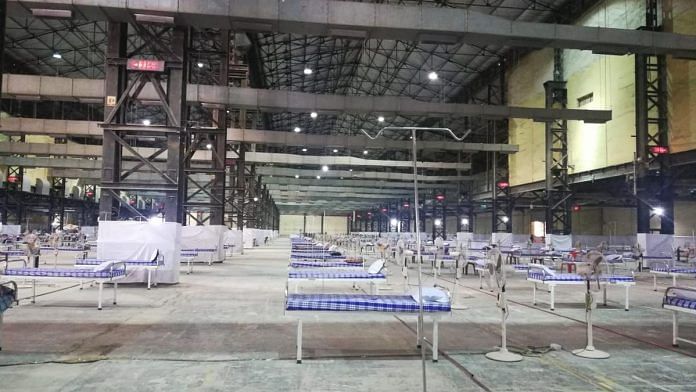New Delhi: Unpredictability is the most scary feature of Covid-19. What if it was possible to predict who would get what symptoms and who would eventually need oxygen or ventilator support? In an attempt to find answers to those questions, researchers from King’s College London have, in a non-peer reviewed paper, categorised patients into six “clusters” based on their symptoms.
Their contention is that not all Covid-19 patients show all the symptoms and by correlating these, an assessment could be made about who might end up in the “severe” disease zone.
Among the known symptoms of Covid-19 are fever, cough, fatigue, shortness of breath, muscle pain, sore throat, diarrhoea, and loss of smell and taste.
The study
Using a smartphone app, the study obtained data from “1,653 users of the app with persistent symptoms and regular logging — from disease onset until hospitalisation or beginning of recovery — for which the data inclusion cut-off was 30 April 2020”.
An independent replication set consisting of 1,047 participants was created for comparison.
The researchers wrote: “Compared to Cluster 3-6, of which 8.6 per cent-19.8 per cent required respiratory support, Cluster 1 and 2 represent milder 5 forms of Covid-19 with 1.5 per cent and 4.4 per cent, respectively, requiring respiratory support.”
“These clusters showed predominantly upper respiratory tract symptoms and were distinguished from each other by the absence of muscle pain in Cluster 2 compared to Cluster 1, and slightly increased reports of skipped meals and fever in Cluster 2,” they wrote.
“Cluster 1 had notably lower mean age and BMI than the clusters containing patients with higher likelihood of requiring respiratory support. Cluster 3 shows stronger gastrointestinal symptoms in isolation (diarrhoea, skipped meals) and a relatively reduced need for respiratory support, of 3.7 per cent.”
“However, the associated rate of hospital visit was high compared to Cluster 1 and 2. Cluster 4, 5 and 6 included participants reporting more severe Covid-19 with 8.6 per cent, 9.9 per cent and 19.8 per cent of individuals within these clusters, requiring respiratory support, respectively. These three clusters represent distinct 5 presentations, with Cluster 4 marked by the early presence of severe fatigue and the continuous presence of chest pain and persistent cough,” the researchers said.
Individuals in Cluster 5 reported confusion, skipped meals and severe fatigue. Those in Cluster 6 reported more marked symptoms of respiratory distress, including early onset of shortness of breath accompanied by chest pain.
“These respiratory symptoms were combined with significant abdominal pain, diarrhoea and confusion when compared with other clusters. The proportion of frail people was higher in Cluster 5 and 6 than in what we consider to be the milder clusters,” they added.
Also read: New outbreak in China indicates coronavirus might be changing
The classification
To sum up, this is what the classification the researchers have arrived at looks like:
Cluster one — More likely to have a sore throat, persistent cough, headache and loss of smell. May have chest pain, but unlikely to get shortness of breath. Suffers from muscle pains but mostly complains of the upper respiratory tract being affected but usually no fever.
Chances of needing respiratory support for this cluster is 1.5 per cent.
Cluster two — Reports with cough, fever, headache and sore throat. Could be skipping meals and also suffer from loss of smell as the disease progresses.
Respiratory support — 4.4 per cent.
Cluster three — The respiratory symptoms are less pronounced but there is diarrhoea and a loss of appetite causing the person to skip meals.
Respiratory support — 3.7 per cent.
Cluster four — Cough, chest pain and headache are the predominant symptoms. There is fatigue as the disease progresses and mild fever in some cases. There is also loss of smell in the later days.
Respiratory support — 8.6 per cent.
Cluster five — There is headache, fever cough and sore throat with diarrhea, skipped meals, muscle pains, chest pain abdominal pain, hoarse voice and loss of smell.
Respiratory support — 9.9 per cent.
Cluster six — Almost all the symptoms are present, including shortness of breath as the disease progresses. There is acute headache, fever, cough and loss of appetite.
Respiratory support — 19.8 per cent.
Talking about the utility of the study, the researchers said: “The ability to predict medical resource requirements days before they arise has significant clinical utility in this pandemic. If widely utilised, healthcare providers and managers could track large groups of patients and predict numbers requiring hospital care and respiratory support days ahead of these needs arising, allowing for staff, bed and intensive care planning.
“As a clinical tool, this approach could be implemented at local level, allowing patients to be monitored remotely by their primary healthcare teams with alert systems triggered when individuals demonstrate symptomatology associated with a high-risk cluster.”
Also read: Most children have mild form of Covid-19, face minute risk of death, Lancet study finds






